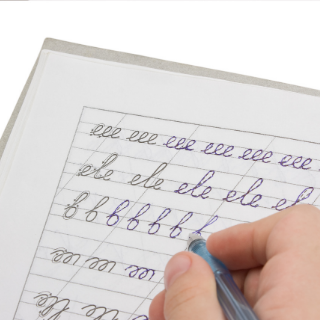
This language lesson is designed for 6 to 12-year-old children to guide them on how to write the English alphabets t and i in cursive.
Handwriting practice helps in strengthening the finger muscles and developing fine motor skills. It also helps the child to develop and practice hand-eye coordination. And introducing activities that involve writing in cursive is still seen as a worthwhile endeavor. Often, children retain more information when they write than when they listen or type.
Although in the age of tablets, cursive writing may seem like a different era but it is still an important skill for children to learn today. It extends well beyond the classroom, which makes cursive instruction essential for children’s success.
How to Write the Letters t and i in Cursive?
In this video lesson, we will learn to write cursive t and cursive i. These 2 letters belong to the up-and-down stroke family and this family likes to jump straight up. Here, these letters are introduced as Tony and Isabelle.
The letter i is the middle zone letter which means it lies between the headline and the baseline, whereas the letter t is the upper zone letter, which means the letter starts from the baseline and goes to the top line through the headline.
- To write cursive t: Begin with the baseline. Make an under-curve towards the headline. Bring the stroke to the baseline with a down curve following the previous curve. Extend towards the right and leaves as a connector to join other cursive letters. Draw a sleeping line from left to right a little above the headline.
- To write cursive i: Begin with the baseline. Take the stroke to the headline with an under the curve. Comes down to the baseline with a down curve following the previous curve. Leave the stroke with a connector on the right side to end the letter or to join other cursive letters. A dot is placed a little above the headline to complete the letter.
Effective Steps to Teach Cursive Writing At Home
When you are setting up to take cursive writing at home, it is good to consider a few points. This would make it easier for the child to set the right pace and attain good writing.
- Follow and practice the same pattern letters- for example, letters in up and down strokes.
- Using verbal cues such as learning the stroke families makes it easier for the child to remember the flow of the stroke.
- You may use dotted worksheets with starting and ending arrows. Such worksheets also mark the flow of strokes with numbers.
- The correct angle of the paper (approximately 45 degrees) should be set to get the correct flow of the strokes.
- To enhance the pencil grip for good handwriting, practice fine motor skills activities at home like coloring, and playing with clay or regular dough.
- Give the child enough time to understand the pattern and stroke. Let them practice at their own pace.
- Let the child practice one letter of the stroke family at a time and then move to another one.
- Good posture is always important. Straight back and flat feet on the floor with the right distance between the desk and the eye should be maintained.
Note: Let the child try writing the cursive letters in a notebook while watching the video. This will help the child write the letter in proper flow and accurately. The children will become more comfortable with cursive alphabets as they watch and write.
Watch the video to learn more about how to write cursive letters t and cursive i using the right stroke. Repeat this activity by asking the child to practice the t and i alphabets in cursive, as shown in the video.
Related Video Resources:
To watch more language video resources, click here.
Video Created by: Jodi Qualters (Montessori in the Park, Goodyear, Arizona
Tags
- cursive writing
- Elementary
- English
- Language





